Halo 2, the long-awaited sequel to one of the most widely praised, most influential first-person shooters ever created, has a very tough act to follow. Fortunately, it's built on a foundation that's as strong as they come. The game's success was preordained--publisher Microsoft tallied more than 1.5 million Halo 2 preorders in the weeks leading up to the game's release, which demonstrates just how confident Halo's fans are in the sequel's quality. But how is it, really? The good news is, the sequel to the Xbox's defining action game is an absolutely superb, fully featured game, boasting an excellent presentation, a highly replayable campaign, and the greatest, most complete online multiplayer component in a console shooter yet. A surprisingly disappointing story and a fairly short single-player portion are noticeable shortcomings, but there's just so much breadth of content in Halo 2, and the action itself is so outstanding, that there can be no denying its quality. Overall, it's one of the very best action games available.
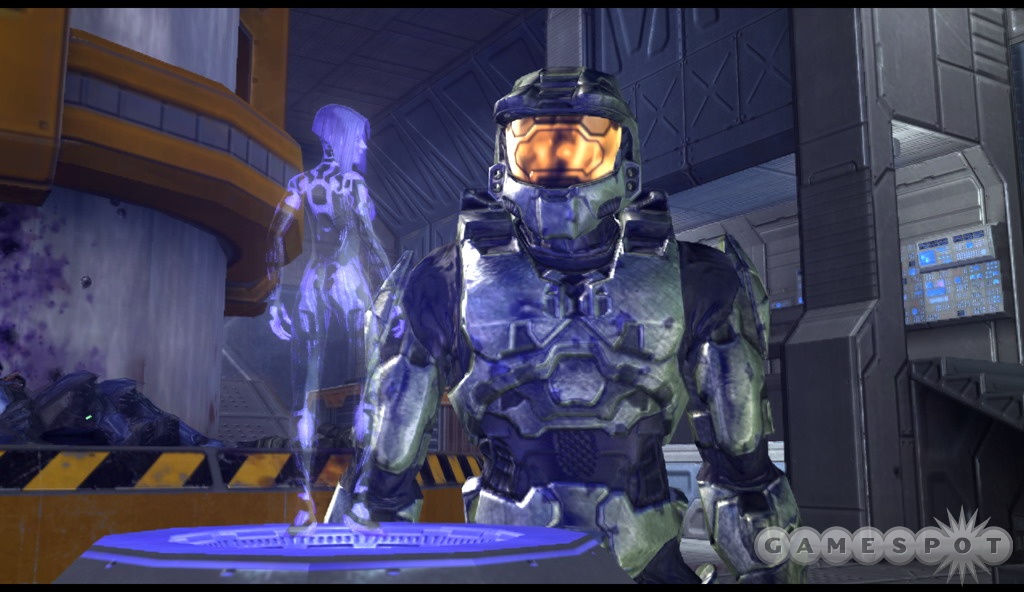
There are several reasons why the original Halo ranks up there with a very small number of other first-person shooters as one of the definitive games in the genre. For one thing, Halo succeeded at establishing a cohesive, memorable, and original science-fiction universe. For another, the Master Chief, Halo's cybernetic protagonist, made a great hero. A fearless, enigmatic man, the Chief could succeed where pure flesh-and-blood humans could not, and guiding him to victory against the alien menace known as the Covenant, as well as the parasitic creatures called the Flood, made for a gripping story and an intense and satisfying gameplay experience.
Halo's gameplay was amazing in that it seamlessly integrated top-notch first-person shooting with incredibly fun third-person vehicular sequences and outstanding friendly and enemy artificial intelligence. The game's subtle innovations--the tactical consequences of such things as having recharging energy shields, being able to carry only a couple of weapons at a time, the ability to throw powerful grenades in between shots, and the option of dishing out fierce melee attacks--also did a lot to differentiate Halo from other shooters, and proceeded to influence subsequent games. Halo's multiple, well-balanced difficulty settings, two-player cooperative campaign option, and assorted multiplayer modes also ensured that the game had tons of lasting appeal. All these factors contributed to the game's well-deserved success, and they're all back in Halo 2. For the most part, the sequel takes an "if it ain't broke, don't fix it" approach to its gameplay--everything that you loved about Halo's action is back in full effect here. At the same time, the handful of new additions in Halo 2 are well thought out and well implemented, enriching the gameplay and making it seem fresh but still familiar.
Everything that you maybe didn't love about Halo is pretty much back, too. Let's face it: Halo was an incredible game, but some aspects of it were relatively weak. Most notably, many players felt that the game's occasionally repetitive level designs undermined the action, such as when the Master Chief squared off against the Flood in the infamous Library level. Also, though the game's visuals were terrific in the heat of battle, Halo's cinematic cutscenes using the game's 3D engine left a lot to be desired--they looked decidedly rough when compared with the rest of the game. These shortcomings rear their heads again in Halo 2, at least during the game's campaign. Some of the in-engine cutscenes are kind of ugly, though they're much better than those of the original. Meanwhile, the action itself is as dynamic and intense as ever, to the point where it can be tons of fun to replay the same sequence over and over, since you'll find that the friendly and enemy forces you'll be battling with will never act quite the same way twice. However, Halo 2's campaign--though it features a number of memorable, spectacular set pieces--frequently boils down to straight-up run-and-gun corridor crawls, one after another.
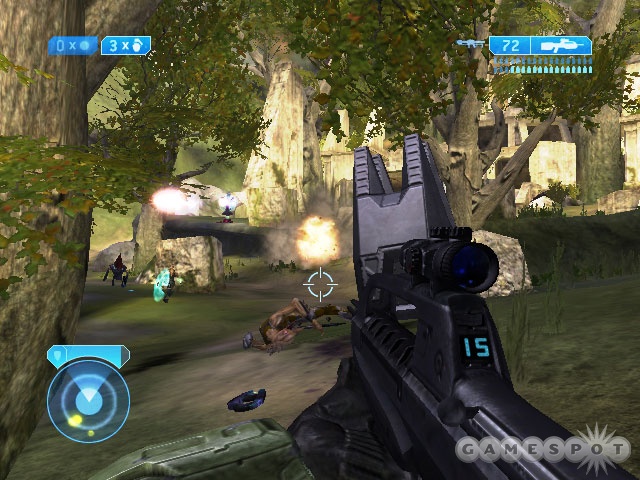
All your attention tends to get concentrated on the action itself, partly because the action is just so good but also because there's often little of interest in the game's environments. The level design is quite striking at times--you'll find yourself stopping just to gaze at the architecture--but it's occasionally monotonous enough to be confusing. You'll sometimes wander aimlessly for a few minutes, unable to tell which way is forward and which way is backward, until you happen upon the next signs of enemy resistance. Basically, the campaign is still a linear series of shootouts, some of which are open-ended enough to afford you the ability to choose from multiple weapons or vehicles, and some of which are more rigid. If the Flood levels of Halo didn't bother you, then you probably won't mind the similar sequences in Halo 2. If you don't fondly recall those bits of the first game, though, you might find yourself frustrated that Halo 2 follows a similar formula.
Even the content of Halo 2's campaign isn't significantly different from that of the first game. Prepare to take on many of the same foes in many of the same types of situations and locales. Of course, the game does take you into some new territory and pits you against some new threats (such as some hard-to-hit flying enemies and an enormous spiderlike Covenant battle tank), and sure enough, these sequences turn out to be some of the best bits of the campaign. Early on, for instance, you'll be defending Earth itself from a Covenant assault, rampaging through the war-torn streets on foot, at the wheel (or the mounted turret) of a Warthog 4x4, or in the belly of a devastating Scorpion battle tank. All this is thrilling. Yet while it's hard to imagine a better setup for Halo 2's action than putting the fate of Earth's defense in your hands, the game turns out to have other intentions, and rather suddenly changes gears after just a few hours.
Halo 2 gives up some of its focus from a storytelling standpoint, which becomes especially apparent once you finish the campaign. A great deal of attention is paid this time around not to the humans struggling for survival, but to the Covenant and what turns out to be a major political upheaval within their ranks. You spent the first game indiscriminately killing these fiends--yet now you're expected to be sympathetic to them and their hatred for humankind. To the game's credit, all this adds some newfound complexity to the story (even the collector's edition version of the game's manual is written from the Covenant perspective), and the plot itself is executed quite well. Still, chances are you'll wish that the game spent less time telling you about the Covenant and more time telling you about the Master Chief, his trusty AI companion Cortana, and, well, the fate of Earth.
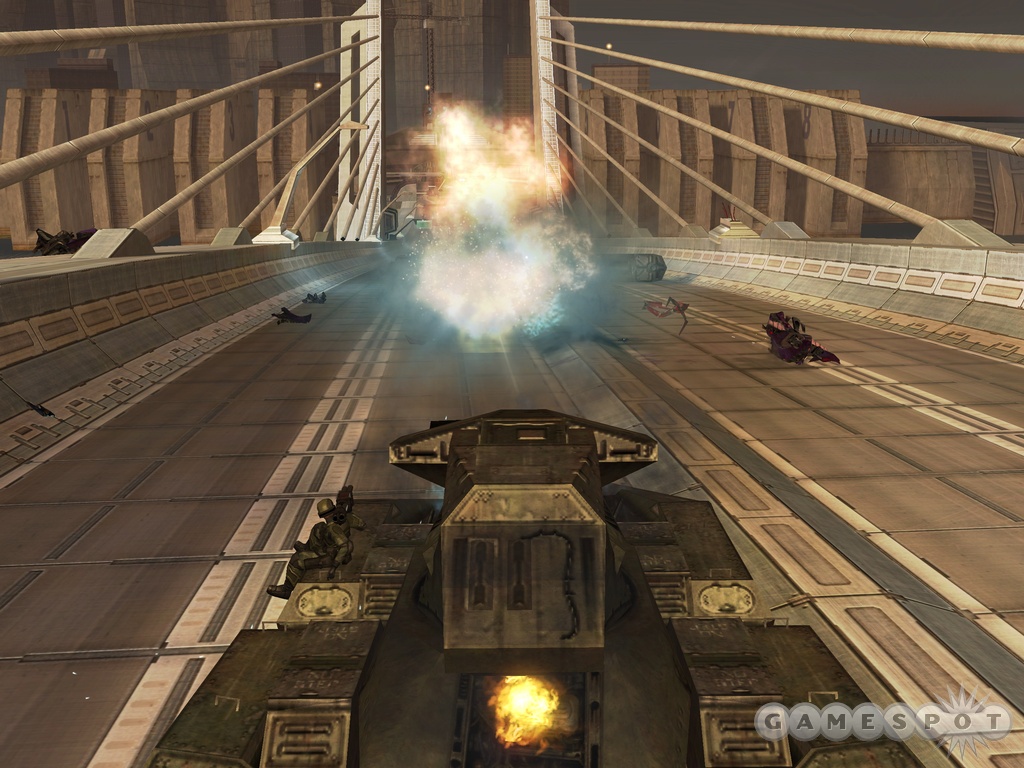
As previously suggested, easily the worst part about the story is the way it ends, insofar as it doesn't. You'll run into this game's cliff-hanger ending like a compact car into a brick wall, and you'll certainly be left aching for more. Cliff-hanger endings are not necessarily a bad thing--some of the most successful film franchises in history (Star Wars and Back to the Future, to name just two) have relied on cliff-hangers to sustain their audiences' feverish excitement over time. The difference is, those cliff-hanger endings arrived in the context of storylines that at least offered some resolution or catharsis, whereas there's little satisfaction to be found in the ending here, and there's no telling when the next Halo game will come around to potentially wrap things up. There's a good chance you'll feel emotionally betrayed by the story, and it certainly doesn't help that the campaign, at the default difficulty, is going to take an average player less than 10 hours from start to finish. Many excited Halo fans will quickly blow through it in a day, or even a single sitting. Yes, the actual gameplay of Halo's single-player campaign is a blast. But the campaign also winds up being the most disappointing part of the game--probably the only disappointing part. Fortunately, Halo 2 more than makes up for these shortfalls in other ways.
From a technical standpoint, Halo 2's campaign features some significant improvements on the original. Some of the battles are on a noticeably grander scale, with many more vehicles and enemies mixed in for chaotic, breathtaking results. Much like the original, Halo 2 features some pitched battles involving more than two opposing factions, and it's great to be able to either lie low and watch the fur fly, or take advantage of the situation. Halo 2 also offers a virtually seamless gameplay experience, with only occasional split-second pauses in the action to divide up miles and miles of combat zones. Saving and loading is also handled extremely well, in that it's done automatically. Intermittent checkpoints punctuate the action, and you'll start back at these should you die or quit playing for a while--you never need to manually save your progress. Furthermore, the enemy AI is as impressive as ever, fighting with nearly the same unpredictability as a human opponent. The AI has a few weaknesses, especially when it's in the driver's seat of a vehicle, where it has trouble steering around obstacles, but it's still interesting and fun to fight both with and against.
Halo 2 plays very similarly to the original, but there are some key differences. Your jump is higher and floatier this time, and you don't suffer damage from falling anymore. There's no longer a health meter to worry about, which might sound like a pretty severe change, but it simply means that, unlike in the original game, you never need to concern yourself with finding health packs. It's just you and your recharging energy shields, which again give the game its tactical pacing--a slightly faster pacing than before, actually, since your shields recharge more quickly than in Halo. You can run and gun for a while, but when your shields are depleted, it's time for a hasty retreat behind cover. You can withstand a few light hits after your shields are drained, but that's it.
It's now possible to dual-wield some weapons--the smaller, one-handed ones. This isn't exactly an original feature, but Halo 2 implements it very well, both in single-player and multiplayer. When you're dual-wielding, you can independently fire both weapons using the left and right shoulder buttons. This leads to double the stopping power, makes some previously underpowered weapons (such as the needler) quite potent when used in tandem, and creates the potential for some inventive weapon combinations. On the other hand, while dual-wielding, you cannot throw your frag grenades or plasma grenades (which any Halo player knows are extremely useful), and you cannot execute melee attacks without automatically dropping the off-hand weapon in the process. So, dual-wielding doesn't dominate the game; it has its place, and it's an interesting addition to the game's tactics.
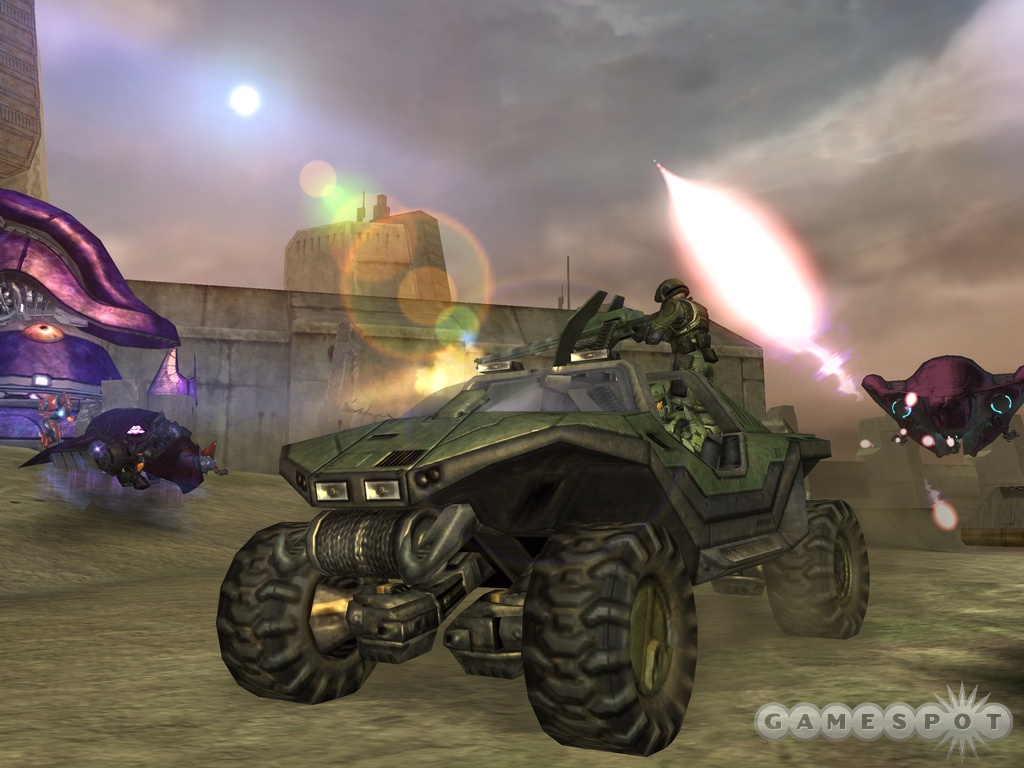
Halo 2 also sports a few vehicles not seen in the original, but the first game's vehicles get most of the attention. Fortunately, they've all been freshened up a bit. The Warthog can now powerslide for even tighter turns than it was capable of before. The Ghost, which you'll remember as the Covenant's one-man attack hoverbike, is probably the most fun-to-drive vehicle in the game now, thanks to the addition of an afterburner that makes it superfast and very deadly as a battering ram (the Ghost's plasma cannons are disabled while boosting, though). The Banshee, the Covenant's hang-glider-style flying vehicle, can now perform barrel rolls and loop-de-loops, and it also has an afterburner-style boost. It has a powerful main cannon that you'll get to use in the single-player portion of the game, but in multiplayer it's limited to its rapid-fire plasma guns.
Also, all the vehicles in Halo 2 now noticeably sustain damage when struck, but this effect is mostly cosmetic. It looks really terrific, to be sure--location-specific damage means you'll see the vehicles get shot apart piece by piece, depending on how you hit them. However, even if you're piloting a burning husk of a vehicle that seems held together by duct tape, chewing gum, and hope, it won't blow up unless your shield meter is depleted and you're killed as per usual. This seems counterintuitive, but then again, not having to worry about your vehicle's health independently of your own certainly doesn't hurt the game. And besides, if your opponent is sporting a shinier ride than you are, you can try to take what isn't yours.
The ability to hijack vehicles is probably the single greatest addition to Halo 2's play mechanics. It's done by simply pressing the X button when you're in the proper position, but getting into position can be tricky when you're face-to-face with a vehicle bristling with deadly weapons. Still, should you flank a vehicle and execute the command, you'll see yourself "remove" the opponent from the driver's seat and replace him. The particulars of the act depend on the vehicle (for instance, you'll actually have to bash open the hatches of the game's tanks and flush the crew out with grenades before taking control), but the bottom line is it's possible to turn the tables on a heavily armed opponent. This can lead to some incredibly satisfying unscripted moments in both the single-player and multiplayer portions of the game, such as when you jump up and grab onto a low-flying Banshee and fling its pilot into a bottomless pit, or when you jack a Ghost and make crushing its former owner your first order of business.
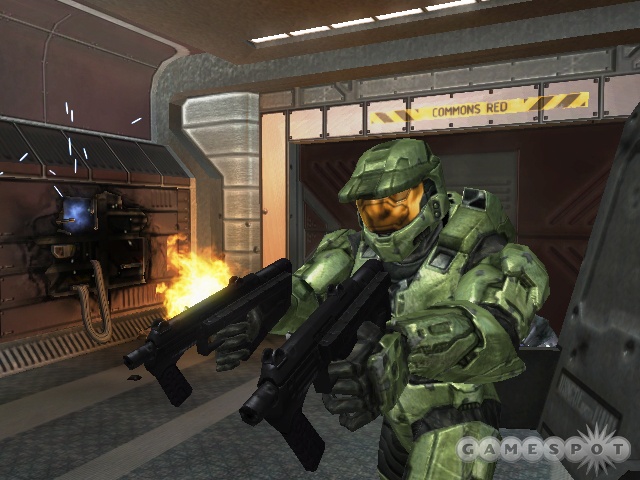
Halo 2 also features a number of new weapons. The most exciting of these is the energy sword, which some of the Covenant used to make your life miserable in the first game, but which you couldn't use--until now. The energy sword is as deadly as you remember, though the obvious disadvantage is its lack of reach. However, its reach is better than you'd expect. If you get within about 10 feet of an opponent and center him in your sights, you can execute a very quick lunge that will instantly kill the target 90 percent of the time. In the single-player campaign, the energy sword will prove to be a reliable tool whose only real drawback is its limited energy capacity--basically, it can run out of ammo. In the multiplayer modes, for whatever reason, there's no ammo limit on the sword, which can make it seem somewhat overpowered in some of the more-confined multiplayer maps. Whatever the case, the energy sword is a lot of fun to use. It sizzles with crackling energy and looks every bit as deadly in action as it truly is.
The other new weapons include the Covenant beam rifle, a highly effective sniper gun that can fire as quickly as you can pull the trigger but overheats if you don't space out your shots. There's also the Covenant carbine, a semiautomatic rifle with a decent scope, and its mean-looking human counterpart, the battle rifle, which fires in three-round bursts and is effective from afar. The submachine gun is another new addition, and it effectively replaces Halo's dearly departed assault rifle, which is nowhere to be found in Halo 2. The submachine gun doesn't pack much punch on its own, but dual-wielding them can be very effective. Also, the massive Covenant hunters' devastating fuel-rod cannons from the original Halo can now be wielded (which was first possible in the multiplayer mode of the PC version of Halo). Another new weapon, the brute shot, is a semiautomatic grenade launcher that requires good aim but causes terrific damage.
Most of Halo's weapons are back, with the magnum (which no longer has a scope, to the benefit of the multiplayer game), the shotgun, the sniper rifle, the rocket launcher (which can now lock on to vehicles, making it even more dangerous), the plasma pistol, and the plasma rifle all making a return. Once again, the human weapons are basically more satisfying to use, since they pack a more visceral punch. But, all in all, Halo 2's arsenal is diverse, balanced, and interesting. You'll frequently be challenged to make tough decisions on the fly about which weapons you should hang on to.
Of course, the core of Halo 2's action is still totally top-notch. It gets all the small, important stuff right. For instance, the game gives you excellent feedback using both graphical and audio cues about when you're hurting the opponent and when you yourself are being hurt. There are intuitive indications when your shields are charging up, when your ammo's running low, when you need to reload, and so on. As a result, you really don't need to spend much time glancing at the heads-up display elements in the corners of the screen--you can squarely concentrate on the action in front of you. Also, in multiplayer, onscreen waypoint indicators help you keep track of friendly players, turning into Xs when they're killed and generally letting you know where your help is needed in a clean, unobtrusive fashion.
Melee attacks are once again immensely satisfying and very strong, and consequently are a great way to finish off an opponent, especially in multiplayer. Fans of Halo's melee attacks will be pleased to find that there are even more attack animations this time around, although for some strange reason, some of Halo's best melee attack animations (the overhead shotgun bash and the needler slap, to name a couple) have been replaced with less-severe-looking moves. No matter--these are just as effective as before.
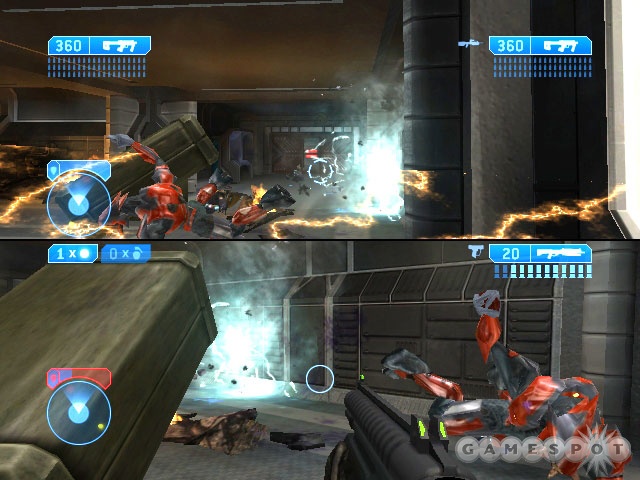
Given that the fundamentals of Halo 2's gameplay are so outstanding, it's fortunate that the campaign offers some breadth beyond the initial less-than-10-hour play-through. There's a two-player cooperative mode, which can be tremendously fun, as anyone who's played the first Halo in co-op could attest. The game runs great in split-screen (even in a four-player multiplayer match), so the co-op mode once again is one of the highlights. Unfortunately, you cannot play the co-op campaign online or via system link, for whatever reason. The single-player and cooperative portions of Halo 2 are given additional lasting appeal thanks to the game's multiple difficulty settings. At the normal setting, the game is actually going to be mostly a breeze for experienced Halo players. The next-hardest "heroic" setting is a better challenge, and should be your choice for co-op play, unless you've been practicing and are up for the toughest experience that Halo 2 can throw at you: the suitably named "legendary" setting, which will bring even the best Halo players nearly to their knees. If you really want to stretch out the offline experience of the game, just play on "legendary" from the get-go and you'll have your hands full for a long, long time, thanks to the droves of incredibly deadly enemies you'll be facing. Actually, once you finish the campaign for the first time, you can play through any of the game's chapters either solo or in co-op at any difficulty setting.
Like its predecessor, Halo 2 supports up to 16 players in its multiplayer modes, though many Halo fans never got to experience the original game's full-scale multiplayer action. They maybe played four-player multiplayer on a single system, but participating in a 16-player system-link game (ideally requiring four TVs, Xboxes, and copies of Halo) wasn't exactly practical. Nevertheless, system-link play remains a welcome option in Halo 2. Obviously, the ability to play with and against others online this time around is a very big deal, especially since Halo 2's multiplayer is so good. In short, this is one the best multiplayer action experiences available on any platform. Though the PC is home to some of the best-ever multiplayer-focused shooters, Halo 2 stands firm even in direct comparison with the PC's finest, thanks partly to its unprecedented player-matching features.
Halo 2's multiplayer options build on the strong foundation established by its predecessor, mostly by taking the action online and introducing a variety of great player-matching features that help make the online play much easier to get into here than in most shooters. In fact, these rather subtle features turn out to be Halo 2's greatest innovations. For starters, you can customize your appearance by choosing from a large variety of different color options and insignias (you can also look like the Master Chief or like a Covenant elite--a purely cosmetic choice). Once you get online, expect Halo 2 to play just as responsively as it does offline; during the course of several days of Xbox Live testing on a standard DSL connection, we experienced perfectly smooth, lag-free gameplay in almost every match.
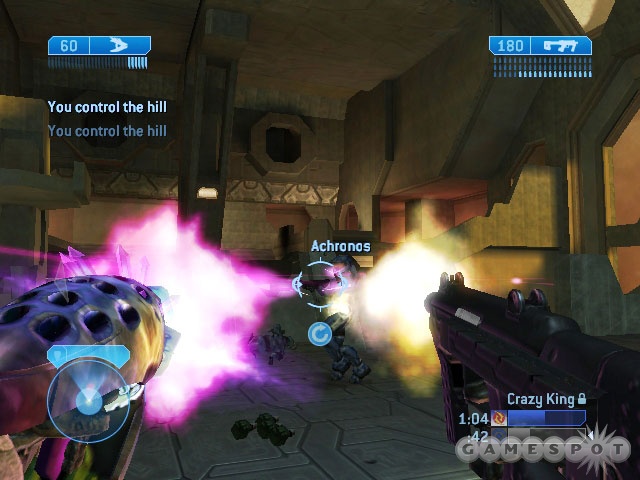
Halo's classic multiplayer modes, including slayer, capture the flag, king of the hill, and oddball, return in the sequel, and are joined by a new mode called territories, which replaces Halo's gimmicky race mode. There are seven different multiplayer modes in total, and each one has several variants, which translates into literally dozens of different possible game types. Multiply this by Halo 2's dozen-or-so multiplayer maps, all of which support each of the different modes of play, and consider the fact that you can customize the game rules to suit your preferences, and it's easy to see that the potential lasting value of Halo 2's multiplayer component is extreme.
Each mode of play is entertaining in its own right--some more than others, though. Slayer, Halo's deathmatch equivalent, is the simplest mode but nonetheless one of the highlights. Team-based and free-for-all variants are available, and you can also limit the action to particular weapons (for instance, swords-only matches can be great fun), or enable the use of cloaking shields for some cat-and-mouse action. Again, since the core gameplay of Halo 2 is so great, just slugging it out against other players--or stalking them using the onscreen motion sensor--can be very fulfilling. Too bad there's no option to play with or against computer-controlled bots, which is a noticeable omission, especially given how good the AI is in the single-player portion of the game.
Besides slayer, capture the flag is another returning favorite. It offers one-flag, two-flag, and other variants that considerably change the dynamic of the action. King of the hill forces players to fight for superiority in a key location on the map. The new territories mode is similarly themed, filling maps with different strategic points that can be captured and recaptured tug-of-war-style for some truly tense and exciting battles reminiscent of the PC's Battlefield series or Unreal Tournament 2004's onslaught mode. Assault is sort of a reverse CTF, requiring players to drop bombs into the opposing side's base. Oddball is a great game of keep-away, in which you're trying to hang on to a skull-shaped "ball" for as long as possible. Juggernaut imbues one player with super strength, and compels everyone else to gang up on him or her. You might easily play Halo 2 for dozens of hours without ever experiencing all the variants of these modes, but chances are, you'll quickly find several mode-variant-map combinations that really suit you.
One potential consequence of being able to freely customize a multiplayer gameplay experience is that you might discover some combinations of modes, maps, and numbers of players that aren't very good. For example, a juggernaut match in which the juggernaut can fly off to safety in a Banshee isn't necessarily much fun, and a four-player CTF match won't work well on some of the larger maps. Still, the game's flexibility is ultimately to its great credit, and the quick match and optimatch features on Xbox Live do a great job of throwing you into ideal game sessions based on your basic preferences, an optimal number of players, and those players' relative skill levels (based on their rankings). To whatever extent is possible in a multiplayer shooter, there's something here for everyone.
The maps themselves are clearly designed with well-balanced multiplayer competition in mind. You'll spot some of the classics from Halo back in full effect here, along with some new maps, including a few that are asymmetrical and therefore very interesting in team-based game types. The maps include sprawling vehicle-focused battlefields and close-quarters corridor crawls, and pretty much every discernible shade in between. There isn't an exhaustive number of maps, but since you need to learn a map to be competitive on it, this isn't a bad thing. Besides, any given map tends to have a noticeably different feel to it, depending on how the chosen mode of play focuses the action. For example, much like in Halo, being in the driver's seat of a Warthog won't be terribly effective in a free-for-all slayer match, but since the vehicle can transport several of your allies, it's much more useful in CTF or one of the other team-based modes.
Many of Halo 2's multiplayer modes encourage or require teamwork, and to this end the game affords you a variety of tools for coordinating with your allies. Online, it's possible to find open sessions not just when playing solo, but also when playing as a team--your entire party can hopscotch to and from different sessions. More than one player can get online with a single Xbox, too, so while you can't play the co-op campaign over Xbox Live, you can take part in multiplayer matches online together in split-screen. During a match, you can use your headset either to speak to whoever's in the general vicinity (friend or foe), or only to your team by pressing the white button. Furthermore, Halo 2 basically gives you all that you need to set up and manage a competitive team (or "clan," to use the long-standing first-person shooter slang, as Halo 2 does), and to track its ongoing progress against other such groups. As a clan, it's also easy to jump into ranked games against other clans, and Bungie's official Web site records some ridiculously detailed statistics about your time spent playing online, so Halo 2 seems well suited to support its hardcore fans.
The game also incorporates a variety of systems to punish players who go out of their way to try to ruin others' experience, including one that penalizes them with increasingly lengthy respawn times. Halo 2 even dynamically switches host servers in the event that the player who created a game session quits out. These types of under-the-hood features may not be obvious, but they should help ensure that the stability and integrity of Halo 2's online play experience lives up to standards set by the gameplay itself. Another aspect of Halo 2 that's incredibly impressive is its audio. The game features Dolby Digital 5.1 support and puts it to good use, since the positional audio can give you a tactical advantage. The sound itself is stunning, too. The weapon effects are memorably fierce, and they're made even more effective through some excellent use of the Xbox controller's force feedback. The voice acting in the campaign is convincingly delivered, and some of it comes from some recognizable talent: actors Keith David and Ron Perlman and comedians David Cross and Orlando Jones, to name a few. Tons and tons of voice work permeates the campaign, and though you'll often hear friendly marines shouting in battle, you'll practically never hear them repeat themselves. Hearing all the Covenant speak English is jarring at first, but their voices still fit them well. With all that said, the music is the best part of Halo 2's sound. It's truly the best "character" in the story, kicking in at the most opportune times and delivering an eclectic sound that includes the stirring strings and choruses of the original Halo, as well as some driving guitar rock that'll really get your blood boiling. 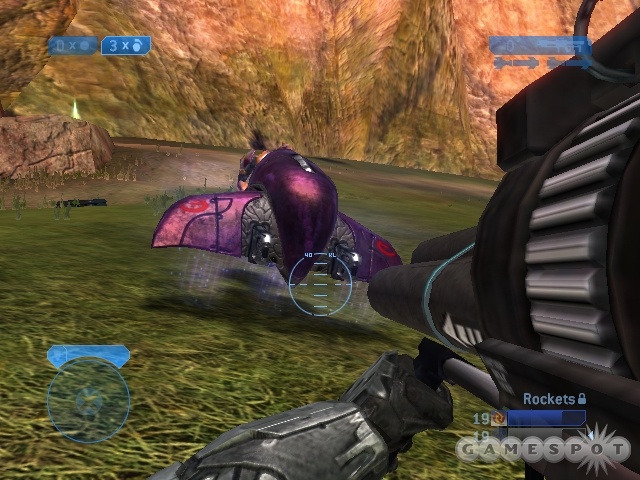
The game's visuals are also very impressive, though they aren't quite as pristine as the sound. As mentioned, some of the cutscenes don't look so hot, and you'll also sometimes see low-resolution textures jarringly switch to much sharper, higher-resolution textures as you approach an object or when the scene changes. Also, some of the game's environments are relatively lacking in detail, despite a prodigious use of bump-mapping, which gives everything in the game a realistically textured look. These rough edges are a bit of a shame, since the rest of Halo 2's visuals present themselves beautifully. The Master Chief, with his well-worn Spartan armor, has never looked better, and the game's outdoor environments seem to stretch for as far as the eye can see. The game usually maintains a respectable frame rate regardless of how much destruction is being waged, and its animations, believable physics, weapon and vehicle designs, and colorful explosions and other effects look terrific. All this makes the game just a lot of fun to watch, especially during densely packed multiplayer matches. Halo 2 of course looks especially good running in progressive-scan mode on a compatible widescreen display. This benefits the game's split-screen modes, too, giving players more real estate and higher resolutions to work with.
To say that there's a lot to like about Halo 2 would be an understatement. Despite a rather short campaign and a disappointing storyline, Halo 2 is an exceptional shooter that frequently delivers thrilling, memorable, and unique moments in its online, co-op, and single-player modes. Depending on what you most want from the game, you may find that Halo 2 leaves you desperate for another installment in the series--but even if it takes Bungie another several years to produce that game, there's enough first-rate action and lasting value here to keep you happily entertained till that time comes.